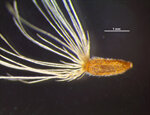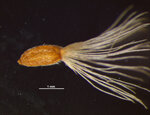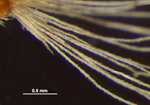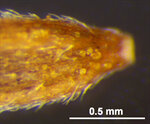Taxonomy
Olearia phlogopappa (Labill.) DC., Prodr. 5: 272. 1836.Common synonyms
Aster phlogopappus Labill., Nov. Holl. Pl. 2: 49, t. 495. 1806.Common name
Alpine daisy bush
Description
Propagule or dispersal unit is the fruit with pappus. Fertile part 1.3-2.2 mm long, 0.4-1 mm wide, in side view widest in upper part (obovoid) or widest in the middle, +/- straight, the upper (apical) end narrowing, in cross-section flattened or angular (prismatic), basal scar (carpopodium) pronounced and well-differentiated, central, beak (=thinner sterile stalk between seed and pappus) absent, wings absent, fruit surface light brown or straw, smooth (except at cellular level), with simple straight hairs or glands or glandular hairs, thickened margin absent, longitudinal ribs present, 6-7, their surfaces smooth, with simple straight hairs.
Pappus type bristles / hairs, pappus elements all +/- similar or clearly differentiated, up to 3-7 mm long, in several rows, pappus elements numerous, persistent, the individual bristles rough / serrated (barbellate), +/- equal width along length, white / translucent.
Notes: At least some of the pappus bristles in the outer row are often shorter than the rest.
Ecology
Shrub, fruits wind-dispersed. Temperate regions. Found in open forests and woodlands, heath, and subalpine areas.
Native range
Australia.
Introduced range
European gardens (not naturalised), New Zealand.
Weed status within Australia
native
Past interceptions (Australia): commodities
Other or unidentified species of the genus also in containers.




